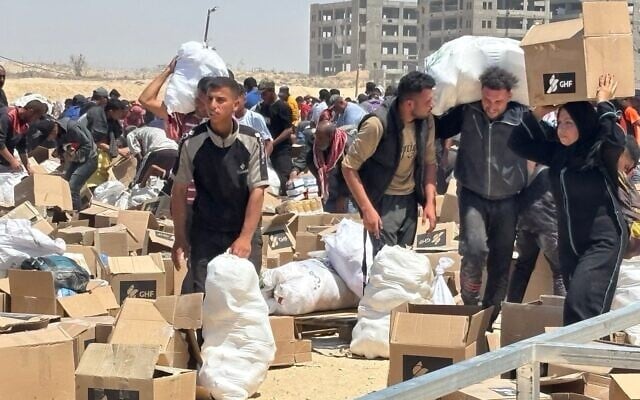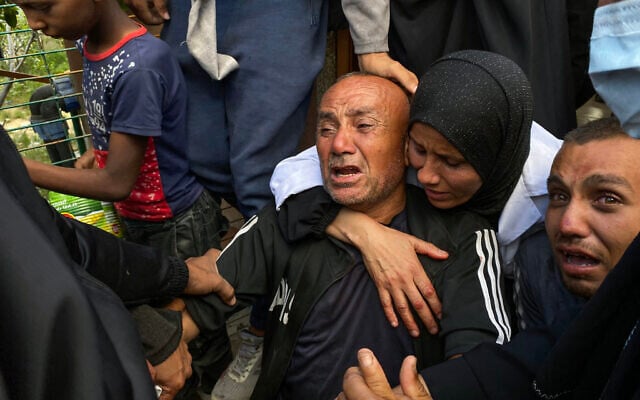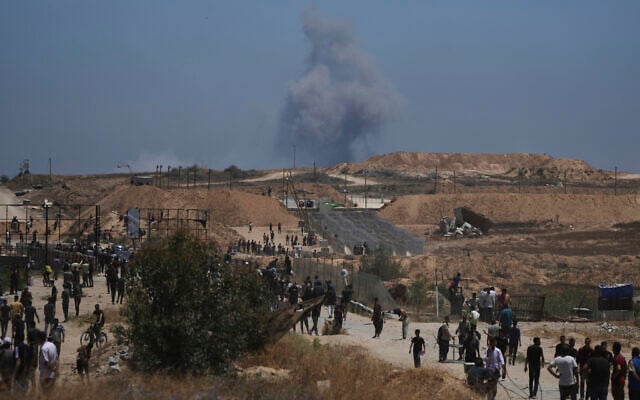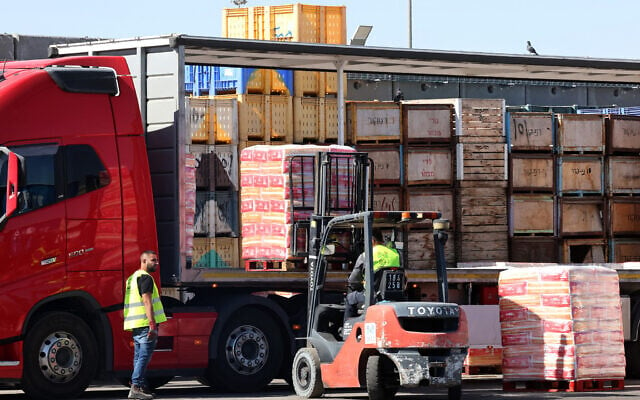


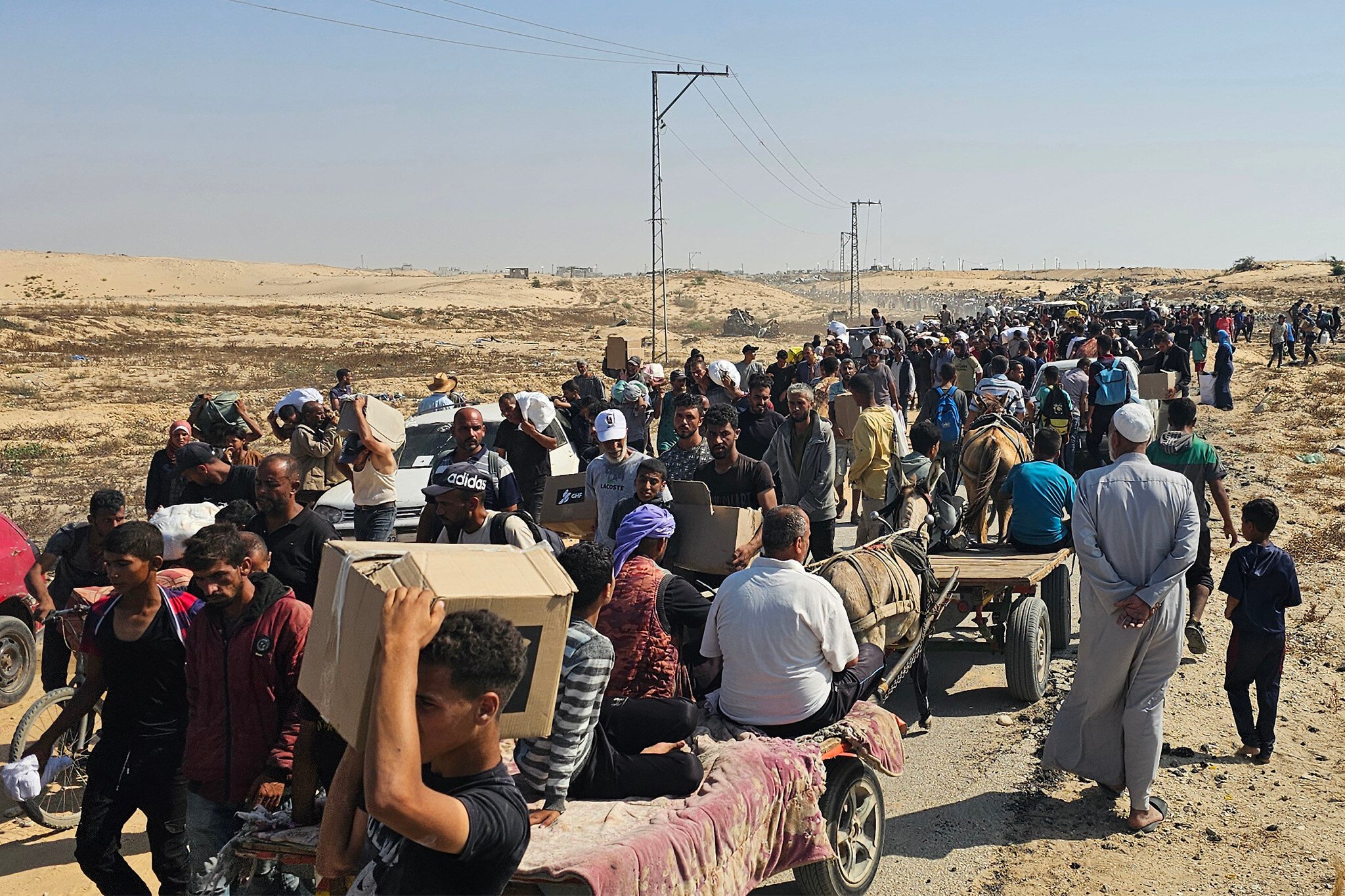
The Gaza Humanitarian Foundation resumed operations near Rafah’s Tel Sultan neighborhood on Thursday afternoon, a spokesman for the organization said, after it shut down aid distribution for over 24 hours to work out security issues, prompted by three straight days of mass casualty incidents.
After Wednesday’s shutdown stretched unexpectedly into Thursday morning, an Arabic-language message was published in the early afternoon, informing Gazans that a new aid distribution site had opened in the Saudi neighborhood of Tel Sultan.
The center is located in one of the large school complexes in the center of the neighborhood, a GHF spokesperson told The Times of Israel.
The new site is intended to replace another location in the so-called Swedish Village area on Gaza’s far southern coast, which was permanently shuttered on Thursday, after just a few days of operations.
Images shared by GHF showed Gazans picking up food from the Swedish Village distribution site ahead of its closure.
The scenes near the unfinished Kuwaiti hospital along the Egyptian border showed some disorder as civilians opened boxes and filled bags to carry, but the area appeared to be relatively uncrowded.
A video clip shared by the group showed a staffer with a camera photographing about a dozen smiling and waving Gazans.
GHF said 18,240 boxes of food were delivered at the Tel Sultan “Swedish Village” site, and 6,720 were picked up at the new site in the nearby Saudi neighborhood.
The foundation says that food in all of those boxes amounts to roughly 1.5 million meals. The products are largely dry foods, though, which require cooking equipment or community kitchens in order to prepare.
The new location in the Tel Sultan area was opened after a brief shutdown of all GHF aid centers, implemented to give time for the US and Israel-backed organization to carry out logistical work needed to accommodate larger crowds.
The closure was also intended to give the IDF time to prepare safer access routes to the sites, a GHF spokesperson said, following days of mass-casualty incidents across the various GHF locations.
The initial mass casualty event came on Sunday as hundreds of Gazans made their way to an Israeli and US-backed aid distribution compound in Rafah — the only one open that day, amid the partial easing of a more than two-month blockade on aid into the Strip.
Hamas-controlled health authorities in the war-torn enclave reported that 31 people had been killed and nearly 200 had been wounded in the pre-dawn shooting near the distribution center in Rafah, for which the IDF largely denied responsibility.
The death toll could not be verified, nor were the subsequent Hamas-issued tolls of three killed on Monday and 27 killed on Tuesday in similar incidents.
The IDF has acknowledged firing warning shots at Palestinians headed to the distribution site before it was open or who approached it from outside the designated safe route. The military said that its fire hit an unspecified number of people, but did not acknowledge killing anybody.
At the same time, it said that Hamas’s claims of dozens killed and wounded were “exaggerated.” In an international press briefing, a government spokesman claimed that reports of IDF troops firing at civilians near aid sites were “based on Hamas propaganda.”
Yet despite the ambiguity of the IDF’s statements, eyewitness accounts, video testimony, and expert analysis cited by separate US and Israeli news outlets on Thursday bolstered claims that Israeli forces had indeed shot at Gazan civilians seeking aid near Rafah.
According to the analyses published Thursday, the IDF was potentially firing in an apparent attempt at crowd control, which experts said was a recipe for disaster given the masses of people involved. However, some eyewitnesses quoted in the reports claimed the military was intentionally shooting to kill.
A CNN investigation cited more than a dozen eyewitnesses, including some who were wounded amid the incident, who said Israeli troops “shot at crowds in volleys of gunfire that occurred sporadically through the early hours of Sunday morning.”
The report noted that GHF had said Israeli forces were operating in the same area during the same period.
The shooting took place around half a mile from the aid distribution site in Rafah’s Tel al-Sultan neighborhood. The shooting’s location, where hundreds of Palestinians had gathered, was confirmed via CNN’s geolocation of videos from the scene.
None of the videos definitively showed who fired the shots.
However, the CNN report cited weapons experts who said the rate of gunfire, as well as photos of retrieved bullets, were consistent with tank-mounted machine guns used by the IDF, and inconsistent with weapons used by Hamas. Multiple people also told CNN they saw gunfire coming from Israeli tanks in the area.
A separate report by Haaretz also cited eyewitness accounts and video pointing to Israel having carried out the shooting. The outlet quoted an unnamed military official as saying that senior officers sought to lay down fire as a way to direct Gazans away from the military position and toward the aid site.
“The intention was to direct the population via fire,” the officer was quoted as saying. “The army treated this like a regular situation of suspects entering a combat zone, but it’s impossible to direct a population at scales this large with fire if you want them to feel safe getting to areas you have opened.”
The military initially denied any role in Sunday’s shooting, although military sources were said to have acknowledged it in private. On Tuesday, however, the IDF confirmed that Israeli troops had indeed fired shots in the area, and said that they were warning shots intended for suspects about a kilometer away.
The IDF did not respond to the CNN report on Thursday, nor did it respond to the Haaretz report.
Although the number of dead and wounded in the incident could not be verified, the International Committee of the Red Cross reported that its field hospital was overwhelmed on Sunday as a result of the shooting, calling it the “highest number of weapon-wounded in a single incident” since it opened the field hospital a year ago.
Doctors at nearby Nasser Hospital, which also absorbed some of the wounded, shared with CNN photos of the bullets taken from the bodies of patients killed in the incident. They were consistent with the type of ammunition used by Israeli weapons, including the FN MAG.
Dr. Ahmad Abou-Sweid, an Australian working at Nasser, told CNN, “There was a heavy proportion of head-targeted injuries from bullet wounds.”
Meanwhile, Gazans who spoke to Haaretz rejected the claim that there were armed Palestinians in the area who may have been responsible for the shooting, rather than the IDF.
One local, identified only by the Hebrew initial Aleph, called the claim “baseless.”
“There were no gunmen. There were planes, artillery and drones. The people who were there were innocent civilians who came to receive a share of the aid,” Aleph said.
“What I saw there is hard to digest — fire for long minutes, in all directions,” they continued. “There was a machine gun on a crane and I saw it firing as if it were a robot, and that’s in addition to the drones.”
“The shooting came from all sides, as though the people who came to the compound were planning an invasion, and not hungry people who wanted food.”
Another eyewitness dismissed suggestions that the first was a failed attempt at crowd control, telling CNN that he had witnessed the deliberate targeting of civilians.
“I have seen a lot of soldiers in this war. When they want to clear an area or warn you, they shoot around you. But yesterday, they were shooting to kill us,” said Mohammad Abu Rezeq, who was shot in the stomach.
While the IDF has not directly responded to the allegations laid out by CNN and Haaretz, it appeared to try and rebuff them in an indirect manner.
On Thursday afternoon, the military published an audio recording that it said was of a conversation between a Gazan man and an officer from the Defense Ministry’s Coordinator of Government Activities in the Territories, in which he claimed that Hamas is the one who opened fire on Palestinians near the Rafah aid distribution site.
“The people who fired were Hamas terrorists,” the Gazan man says, according to a translation provided by the IDF.
“They don’t want the people to receive aid, they want to foil the plan so that the aid will go to them, allowing them to steal it. They’ve gone completely bankrupt,” the man said.
Even with the reopened distribution centers, problems continued to plague aid delivery efforts on Thursday, after a labor union representing Gazan truck drivers said it was going on strike, halting aid deliveries within the Strip.
The Private Transport Association said it was calling the strike in response to an incident on Wednesday in which a convoy of trucks carrying humanitarian aid was attacked by gunmen in central Gaza.
The union said gunmen had shot and killed several drivers in the Deir al-Balah area, and had wounded and abducted several others.
Israel has said that hundreds of trucks packed with food, medicine and other assistance were awaiting transport from the Kerem Shalom crossing to warehouses run by the UN and other humanitarian groups throughout Gaza.
The union’s ties to Hamas are also hazy, as before the war, most unions in Gaza were affiliated with the terror group.
The IDF’s military offensive continued across the Gaza Strip on Thursday, with operations including an airstrike at a hospital in Gaza City.
The military said that the strike at the Al-Ma’amadani Hospital targeted a Palestinian Islamic Jihad command center in the medical center’s courtyard.
The Hamas-run health ministry claimed, however, that the strike had hit a press compound and killed three people.
Reports named one victim as Ismail Badr, a cameraman for the Islamic Jihad-affiliated Palestine Today channel. A second journalist, Suleiman Hajaj, was also killed, according to reports.
The IDF said the compound was being used by Islamic Jihad operatives to plan and carry out attacks on troops and Israeli civilians.
As always, it said it took steps to minimize civilian harm, including by using a precision munition, aerial surveillance, and other intelligence.
Elsewhere in the Strip, Nasser Hospital said it had received the bodies of 10 Palestinians killed in Israeli strikes in Khan Younis overnight.

